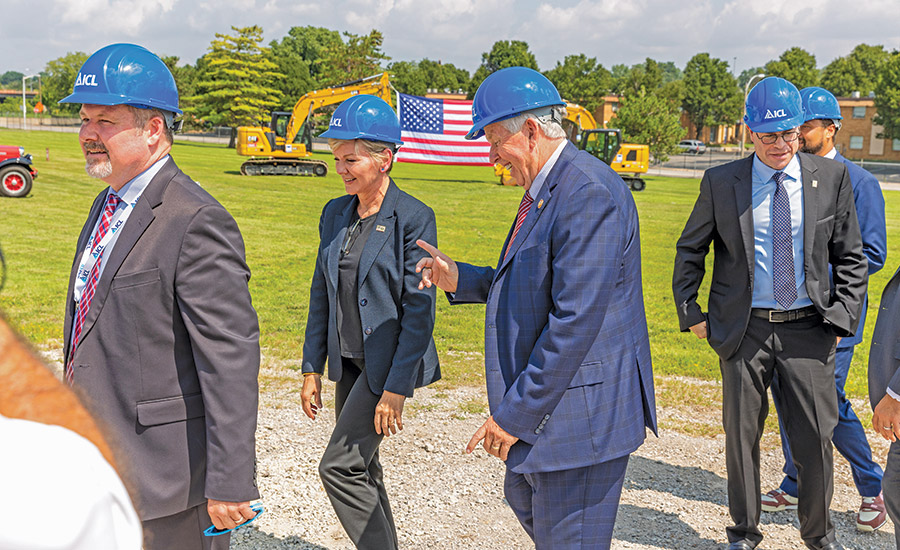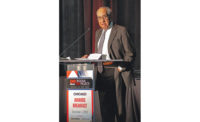McCarthy Building Cos. broke ground recently on a $400-million lithium iron phosphate (LFP) battery materials plant in St. Louis.
The new facility is for ICL, a specialty minerals company, which says it will be the first commercial-scale LFP battery materials manufacturing plant in the U.S. The 140,000-sq-ft plant will produce 30,000 metric tons for use in batteries that can store energy needed to for electric vehicles, charging stations or the electric grid. The new plant will be located on ICL’s existing Carondelet campus in the city and will create 800 to 900 union construction jobs. The project is moving forward quickly.
“The design-build team is implementing collaborative work sessions with our client to fully understand the production flow and equipment requirements,” says Kristyn Newbern, project development director at McCarthy. “Our team’s collaboration will be paramount to the design and construction of this project.
“Our team is proactively working with the entire plant project to identify key schedule acceleration strategies to implement as we progress,” she adds.
ICL is using a $197-million grant from the U.S. Dept. of Energy for construction of the plant.
By 2031, research firm E Source forecasts global demand for iron phosphate-based cathode active materials will reach more than 3 million tons, with a market value of more than $40 billion, due to a shift toward the lower-cost cathode materials used in more affordable EVs and in energy storage solutions. The groundbreaking was attended by Jennifer Granholm, secretary of the Dept. of Energy, and Missouri Gov. Mike Parson (R). The facility is expected to be operational by 2025.

Photo courtesy Skender
Skender has completed a 250,000-sq-ft build-out of Ace Hardware Corp.’s new headquarters in Oak Brook, Ill. The project has transformed the main building on the former McDonald’s corporate campus into a modern, amenity-filled workplace for the hardware retailer. Construction began Feb. 16 and was officially completed on schedule Sept. 18. The Ace Hardware project team included Skender as general contractor, CBRE Design Collective as architect and ESD, now Stantec Consulting Services, as engineer.
The renovation repurposed many of the main building’s original architectural elements, including a large atrium in the center of the building as well as skywells that allow natural light to flow throughout the space. Demountable office and conference room fronts were installed. In addition to being more sustainable and economical than drywall, they create functional, soundproof and visually private interior office spaces. They also enable faster construction and provide flexibility for reconfiguration options in the future.
The project team ran all electrical and low-voltage cabling under the entire second, third and fourth floors, which are built on an existing 6-in. raised-floor system. To combat supply chain challenges, Skender worked with Ace to procure materials earlier than usual and leveraged flexible phasing and work sequencing to further streamline the construction schedule. In addition to Skender’s work on the main building, the landlord converted the first floor of the parking garage into an amenity suite that includes a fitness center, conference center, multipurpose room and large cafeteria and dining center with commercial kitchen.
“We’ve worked very closely with Ace from the early preconstruction, budgeting and design phase all the way through completion,” said Tom Walsh, project manager at Skender. “The Ace team was always welcomed on site, and as a result, we were able to make adjustments early in the process to ensure their satisfaction. We were able to see firsthand their excitement grow with each construction milestone.”
The new Ace headquarters consists of open workstations, 150 conference rooms, 12 cafés/pantries and a variety of collaboration spaces and amenities.
Originally built in the 1970s and designed by Dirk Lohan, grandson of famed architect Mies van der Rohe, the former McDonald’s campus consists of three brutalist-style buildings occupying more than 80 acres. The campus had been empty since 2019, when the fast food giant moved its headquarters to downtown Chicago.





